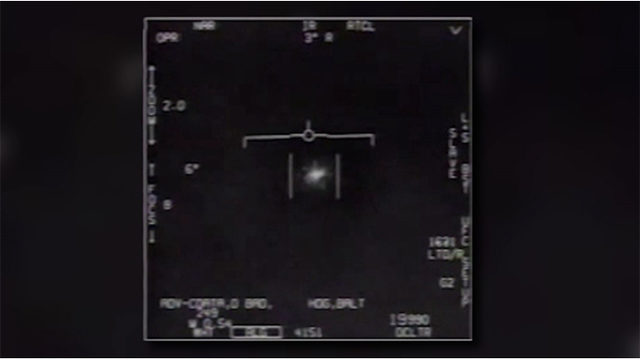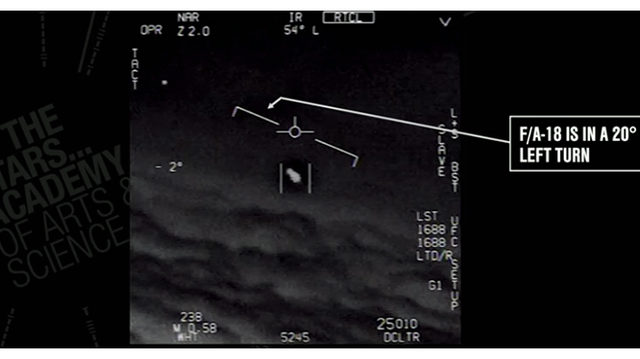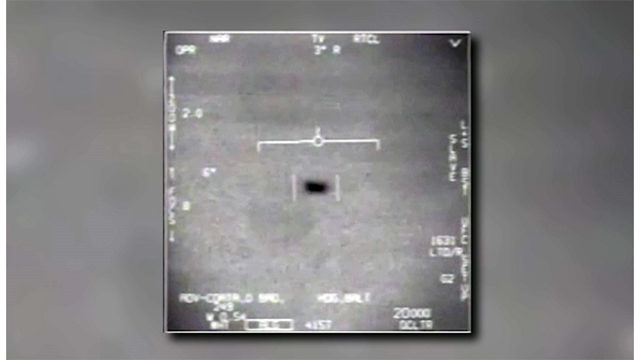
This image is from U.S. military footage of the Tic Tac
Fuzzy videos captured by military pilots caused a media splash over the last six months, but what were those objects in the sky?
Since the Pentagon's release of three UFO videos, armchair experts have speculated that maybe the objects are birds or balloons or something mundane.
But now, the I-Team has obtained an in-depth report prepared by and for the military, and it analyzes the so-called Tic Tac UFO using the most sophisticated sensor systems in the world.
Over a two-week period in late 2004, an unknown, 45-foot long Tic Tac shaped object played cat and mouse with the U.S. Navy off the coast of California. The mighty U.S.S.
Nimitz aircraft carrier, and its support ships including the U.S.S.
Princeton, carrying the most sophisticated sensor systems in the world,
repeatedly detected recurring glimpses of the Tic Tac but were unable to lock on.
On Nov.14, F-18s were ordered into the area and saw it up close. Veteran pilot Dave Fravor, commander of the elite Black Aces unit, says the Tic Tac reacted to the presence of the F-18s then took off like a bullet fired from a gun.
"It takes off like nothing I've ever seen. One minute it's here, and off, it's gone," said retired Navy pilot David Fravor.
In the explosion of media interest that followed the Pentagon's release of the Tic Tac video along with recordings of two other encounters,
Commander Fravor expressed the opinion that the technology was far more advanced than anything known on earth.But in the months since the release, the Pentagon has clammed up. It has declined to release official documents about the
Nimitz Tic Tac encounter, or similar incidents.

This image is from U.S. military footage of the Gimbal UFO incident.
"There are many many
Nimitz incidences that are equally compelling, that are told from the eyes of people like Commander Dave Fravor," said Luis Elizondo, former Pentagon intelligence officer.
Until last year, Elizondo ran AATIP, a secret Pentagon assignment that quietly evaluated UFO incident reports. He chafes at the armchair experts who claim the Tic Tac was a balloon or bird, a mistake by the pilots or a technical glitch.
"Let the data speak for itself," he said. "Let the information we receive from electro optical data; electro mechanical mechanisms be the tool in which we look and compare what the eyewitness testimony is saying."
Elizondo is not authorized to release such information, but the I-Team obtained some of it anyway. Earlier this year, we made a whirlwind trip to Washington for a debriefing arranged by former Senator Harry Reid. While in D.C., the I-Team obtained copies of unclassified documents related to the UFO encounters, including the Tic Tac. The analysis was compiled in 2009 with input from multiple agencies. It confirms the
Nimitz group had several interactions with AAV's, Anomalous Aerial Vehicles.
The report lists the advanced sensors involved at the time, AN/SPY, capable of tracking a golf ball at 100 miles, the E-2C Hawkeye Airborne Early Warning aircraft, as well as shipboard radars and sensors on multiple F-18s which interacted with the Tic Tac, and with something else.
Pilots reported a large disturbance just under the surface of the ocean, round and 100 yards across. It appeared as if the Tic Tac was rendezvousing with the underwater object.Among the key findings in the report --
the AAV is not something that belongs to the U.S. or any other nation. It was so advanced, it rendered U.S. capabilities ineffective. It showed velocities far greater than anything known to exist, and it could turn itself invisible, both to radar and the human eye. Essentially, it was undetectable, and unchallenged.
This image is from U.S. military footage of the Tic Tac.
The report including statements from seven F-18 pilots as well as radar operators on the ships. Despite the seriousness of the encounter, the pilots faced ridicule after their encounters. The Navy's initial report was buried, not forwarded to command. It was decided the AAV was not a threat.
Five years later, a more comprehensive assessment was compiled but was never made public and has been seen by few, even inside the Pentagon.
Former intelligence official
Chris Mellon opined in the Washington Post that the Pentagon's unwillingness to discuss these encounters or share information with other military branches is a threat to national security, comparable to when the CIA and FBI failed to share information prior to 9/11
The analysis report is not dated and has no logo, but four separate people who are familiar with its contents confirmed to the I-Team it is the real deal and was written as part of a Pentagon program.Another highly classified version was also written but is unlikely to ever be released.
Former Senator Reid, now recovering following cancer surgery, hopes that Congress will act to create a new Pentagon program to study these incidents.
You can be among the first to read the report, now posted on here. The only omissions are the names of some of the pilots.
Comment: More on the Nimitz encounters: